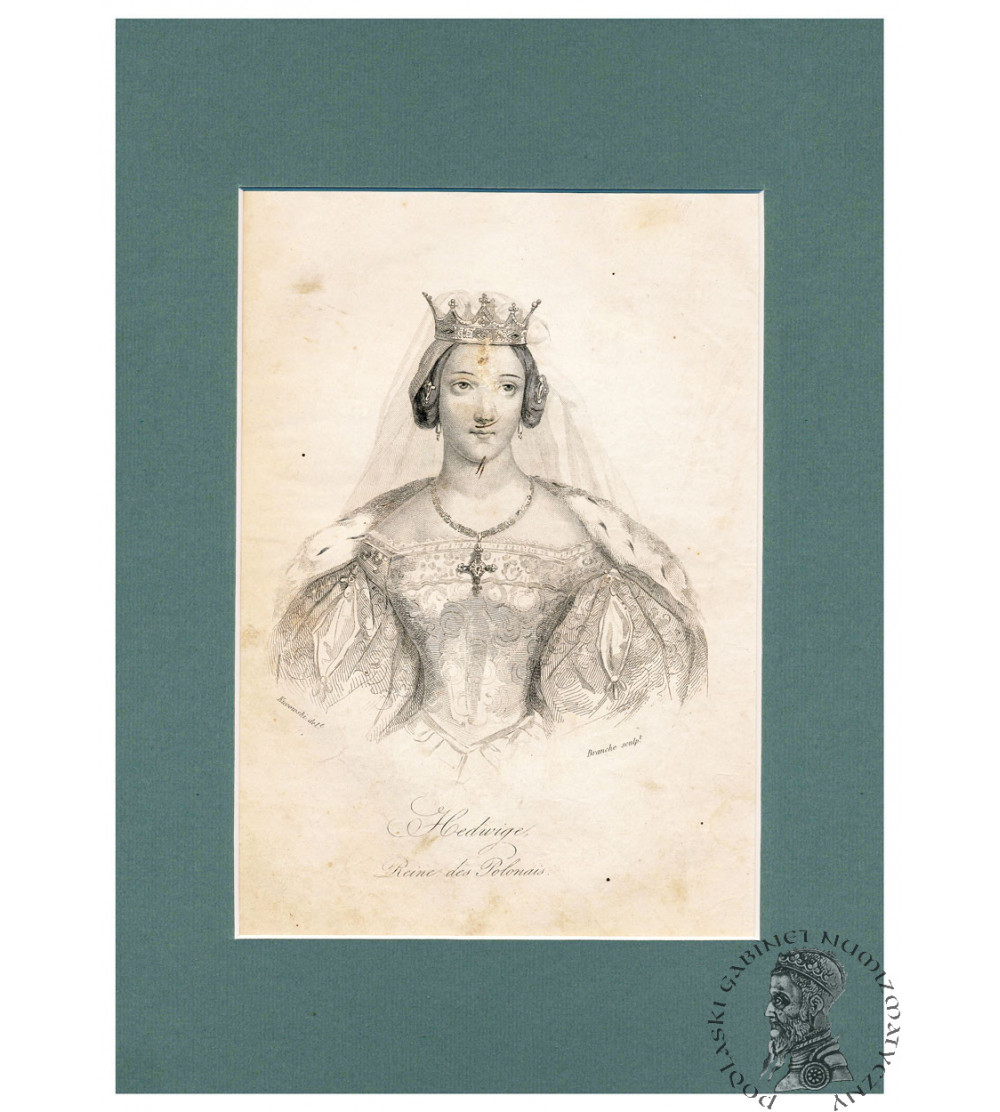




St. Jadwiga Andegawenska, Queen of Poland / Hedwige Reine des Polonais, portrait, steel engraving 19th century, work from Leonard Chodźko's volume - La Pologne historique, litteraire, monumentale et ilustree, Paris 1839-1841, all A4 format (passe-partout), image dimensions 14 cm x 20 cm, good condition, small spots in places.
Jadwiga Andegaweńska (1374-1399) Polska monarchini z dynastii Andegawenów, pierwsza w historii Polski kobieta koronowana nie na królową, lecz na króla. Przyszła na świat najprawdopodobniej w połowie lutego 1374 roku, choć żadne zachowane źródło z epoki nie odnotowało tego faktu. Była trzecią córką, a zarazem ostatnim dzieckiem swoich rodziców: węgierskiego króla Ludwika Andegaweńskiego i królowej Elżbiety Bośniaczki. Z jej narodzinami wiązano wielkie plany, oczekując, że dziecko okaże się chłopcem, a tym samym następcą tronu ratującym dynastię przed widmem wymarcia. Gdy urodziła się dziewczynka, jej ojciec oraz wpływowa babka, stara królowa Elżbieta Łokietkówna zmuszeni byli przedsięwziąć szczególne środki w celu zmiany zasad dziedziczenia – tak by królestwa posiadane przez Ludwika mogły przejść na jego córki. Przed śmiercią ojciec widział w Jadwidze przyszłą królową Węgier. Za jego sprawą dziewczynka została też zaręczona z austriackim książątkiem, Wilhelmem Habsburgiem. Gdy jednak król odszedł, matka dokładała starań, by pozbawić dziewczynkę dziedzictwa, a obydwa trony – polski i węgierski – przekazać w ręce starszej Marii. Jej plany pokrzyżował dopiero opór polskich elit, domagających się dla siebie odrębnego władcy, gotowego rezydować w Krakowie. Po długim i burzliwym bezkrólewiu Jadwiga przybyła nad Wisłę późnym latem 1384 roku i została koronowana na króla 16 października. W lutym 1386 roku poślubiła świeżo nawróconego litewskiego księcia Jagiełłę. Odgrywała stopniowo coraz znaczniejszą rolę w polityce, między innymi podejmując się negocjacji z wielkim mistrzem Zakonu Krzyżackiego. Była mecenaską nauki, wielką miłośniczką książek, kobietą niecodziennej pobożności. Utrzymywała aktywne kontakty ze Stolicą Apostolską i walnie przyczyniła się do odtworzenia krakowskiego uniwersytetu. Zmarła 17 lipca 1399 roku – niespełna cztery tygodnie po porodzie i cztery dni po tym, jak zmarła jej jedyna córka, Elżbieta Bonifacja. źródło: ciekawostkihistoryczne.pl
CHODŹKO, Leonard Borejko (1800-1871), La Pologne historique, litteraire et monumentale, (...), 1835-1842. A monumental work by the famous Polish émigré publisher Leonard Chodźko which is a history and geographic-political description of Poland. The work was published in three volumes. The first part is the history of Poland from the earliest times to the reign of Wladyslaw Lokietek. The second volume covers the history of Poland from the reign of Casimir the Great to the death of Stefan Batory, while the last volume covers the history of Poland from the beginning of the reign of Sigismund III Vasa until the events contemporary to the Author and the Readers, i.e. the November Uprising. Each part also contains descriptions of unique and interesting places in Poland, as well as basic information about literature, art and science. In addition, the work contains examples of exceptional monuments in the Polish lands. An important part of the work includes fairy tales, legends and short stories, as well as an essay on dramatic theater in Poland. The work also contains a description of Polish dances, such as the polonaise, mazurka, and krakowiak. The work is very richly illustrated, with numerous intaglios, natural monuments, sacred objects, castles, palaces, cities, portraits of important historical figures from the history of Poland, works of art, notes of songs, etc. This brings the total to 180 engravings (including maps), in a set of three volumes, i.e. 60 engravings for each volume collated with a table at the beginning of the volume.